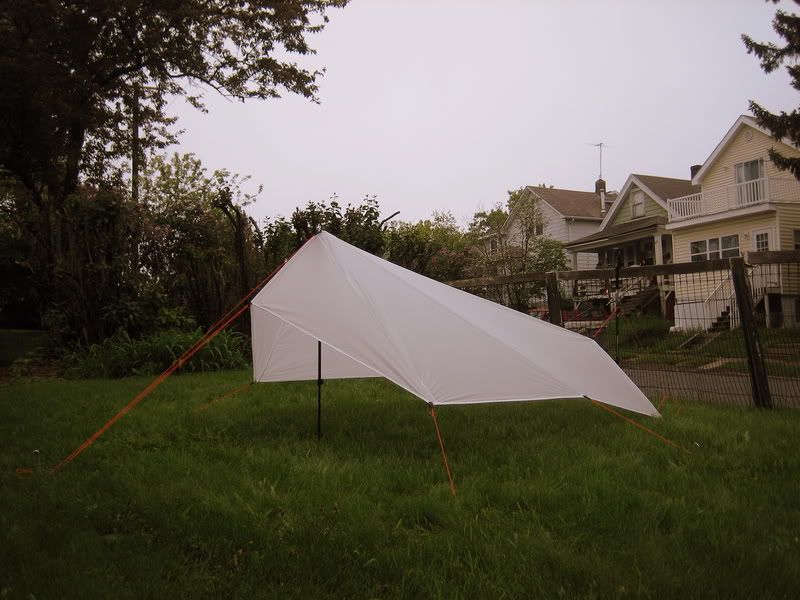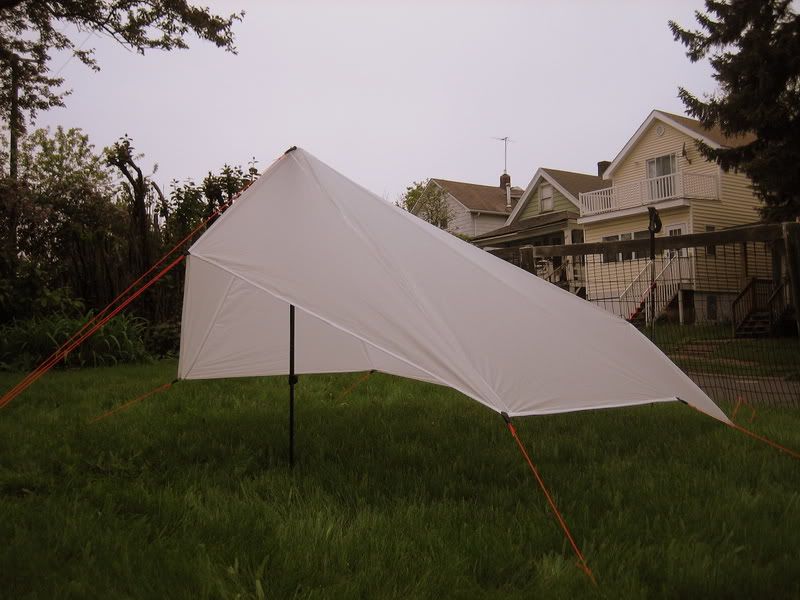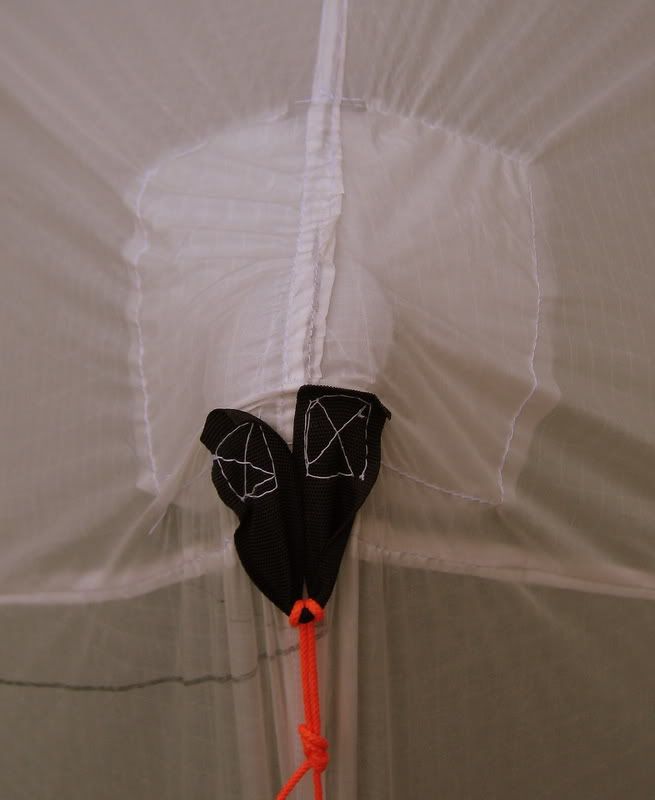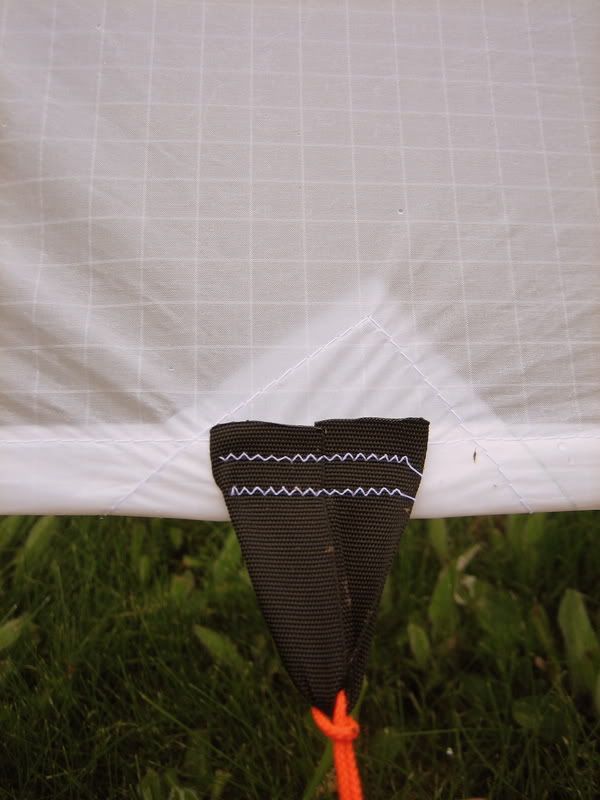Topic
Make Your Own Gear: 5 Yards to SUL, Part 3 – Tarp
Forum Posting
A Membership is required to post in the forums. Login or become a member to post in the member forums!
Home › Forums › Campfire › Editor’s Roundtable › Make Your Own Gear: 5 Yards to SUL, Part 3 – Tarp
- This topic is empty.
-
AuthorPosts
-
Dec 5, 2006 at 7:44 pm #1220580
Companion forum thread to:
Mar 22, 2007 at 3:33 pm #1383219Okay, everything has been going along fine thus far. I've cut the pieces, sewed the ridgeline and am ready to attach the beaks.
I opted to make the ridgeline of my version longer than the pattern called for. In doing so it made the angle of the beak pieces are different than the original pattern. I'm worried that if I sew the beaks on now there will be slack fabric in them when the tarp is pulled taut.

In the diagram I drew above, if I was to flip Part A over and then slide it under Part B do the red and green lines need to match up? The pieces I have currently do not line up in that fashion which is what leads me to believe there would be tautness issues.
Comments please as I'm not spatially thoughtful enough to imagine this in my head and I had trouble getting my CAD program to extrude these shapes.
Mar 24, 2007 at 10:19 am #1383399*bump*
Mar 24, 2007 at 11:15 am #1383400Sam,
Try using clothes pins to "attach" the beak to the tarp body and see how it looks. Hold the tarp up as if pitched.
Worth a try.
Mar 24, 2007 at 11:34 am #1383402Worth a try maybe. We're talking about Spinn fabric here and I don't want to put any holes in it. I'll see if I can find some clothes pins maybe as I know that duct tape won't stick to it. I appreciate your suggestion.
Mar 24, 2007 at 2:40 pm #1383412Sam,
I can't tell for sure from looking at your pictures, but I think you're going to want the other edge of the beak attached to the tarp. I made a similar tarp, though with a less dramatic ridgeline extension. On mine, it was plain that the longer edge (i.e., not at right angles to the ridgeline) of the beak needed to be on the bottom, facing the ground. But if you're not sure I'd either pin/secure it like suggested before OR mock it up with butcher paper or cardboard, even if in smaller scale. I've done that with other projects, and it always pays off.
Pictures are mandatory when you're finished!
Mar 25, 2007 at 11:05 am #1383468Ben,
the photo I used was taken by Jay Hamm and is from the original article. I'm familiar with how the two pieces sew together, what I'm unsure of is whether or not I've cut the angle of the long side properly. Thanks though.
– sam_h
May 30, 2007 at 9:29 pm #1390772After a good long while of putting this project on hold my tarp is very near completion after a four hour sewing session this evening. I just need to attach 9 of the 10 tie-outs and it'll be good to go. I should be able to put those on tomorrow afternoon and maybe even get it outside for some testing and photos. Oh joy!
May 31, 2007 at 9:39 pm #1390902Great Sam! I can't wait to hear how it turns out. Pictures!
Jay
MYOGJun 1, 2007 at 10:58 am #1390942Absolutely, Jay. I finished it at around 11pm last night and – get this – I was so excited I took it down to my local park (in the rain nonetheless) and set it up for the first time.
I'm very happy with my handi-work. Everything pitches tight, it looks nice and provides ample room. I made a couple design changes to mine for comfort. The ridgeline on mine ended up at around 86".
I am a bit let-down by something I simply couldn't envision however. I questioned about it in this thread but wasn't able to come up with an answer however. I won't try and describe the situation until I have a photo to go along with it.
Overall I'm quite pleased with the final product (once I tweak the aforementioend situation) and am excited to pitch up really taut to see if it's durable. I will probably also add tie-outs to the middle of the side-panels to keep them from pushing inward during heavy wind or light snow.
Jun 2, 2007 at 5:47 pm #1391032





 Jun 2, 2007 at 5:56 pm #1391033
Jun 2, 2007 at 5:56 pm #1391033Okay, there's the pictures. Now I need some honest opinions.
1.) Will putting the trekking pole up inside the beak cause too much wear on the spinnaker fabric? The poles are Black Diamond Alpine CFs with a soft rubbery top to the pole. Should I consider draping the stuff sack over the top of the pole or anything like that?
2.) What are folks opinions on my bar-tacks for the side tie-outs? The stitch pattern isn't very tight (compared to say Mountain Laurel Designs which uses a pretty tight bartack).
3.) Note the rear beak isn't even tied out in my photos. The angle I came up with for the rear beak only pulls out from the tarps dripline an inch or two so I don't even know if pulling it taut is worth the weight of a guyline back there. What are your thoughts?
Jun 2, 2007 at 7:41 pm #1391040The seam of your webbing/guylines doesnt look that strong.
especially here:http://i149.photobucket.com/albums/s65/stevenqsteve/Spinnaker%20Tarp/spinn_sidetie.jpgI would sew it twice or even more often. Try to fix start and ending(very low feed motion)
When the seam start to open, due to what reason ever, the rest follow very quickly with your seam.Oliver
Jun 2, 2007 at 7:50 pm #1391042Oliver, thank you for your thoughts. Do you think that putting that many more holes in the fabric will adversely affect the strength, thereby negating the benefits?
Jun 5, 2007 at 10:56 am #1391256Hey folks,
I'm looking for advice and opinions on durability issues related to my tie-out stitches as well as the positioning of the trekking pole against the spinn fabric inside the beak as seen in the photos above.
Thanks,
sam_hSep 7, 2007 at 12:45 am #1401387Jay.
What kind of Gutterman Thread (references) is used for the tarp.
Regards.
ThierrySep 7, 2007 at 2:57 am #1401389> Will putting the trekking pole up inside the beak cause too much wear on the spinnaker fabric?
Looking at the last photo: a extra bit of reinforcing fabric on the inside would not hurt, and an extra ring or two of stitching around where the pole touches would also be a very good idea. I would consider an unproofed Taslan fabric for the reinforcing. The extra stitching will help distribute the load to the roof fabric. Seam seal on the outside later of course.> my bar-tacks for the side tie-outs? The stitch pattern isn't very tight
I personally disagree with the idea of very tight bartacks. The effect of all those holes so close together seems to me to be very similar to the perforations in a roll of toilet paper. Also, by confining the bartacking to a small area you are concentrating the forces too closely. DISTRIBUTE!> so I don't even know if pulling it taut is worth the weight of a guyline back there
If you use very light line for the guys you will find that the weight is negligable. But when the wind blows and things start wobbling around …
I use 150 lb Dacron kite line myself. Is that strong enough? Well, would the tie-out point take your body weight? I thought not.My 2c
CheersSep 7, 2007 at 9:17 am #1401411Roger,
Thanks for your response to my questions. You certainly have a wealth of sewing knowledge and that goes a long way in making suggestions.
You'll be happy to hear that I returned about two weeks ago from a 61 day, 1200 mile trek across the Pacific Northwestern United States and used my spinnaker tarp for 50 of the 61 nights (One night in a shelter, ten nights under the stars). I encountered two nights with significant wind and approximately five nights with rain.
Over the course of the trek the stitching on one of the tie-outs began to come un-done but a simple hand re-stitch put that problem to rest. Otherwise all seams held fast even under some decent wind gusts. I used natural elements at my camping locations such as trees and cliffs to minimize the tarps exposure to the elements as anyone should with any shelters (perhaps a Nemo Tenshi or Rab Summit Extreme aside).
I used the method of placing the trekking pole up into the beak everytime I pitched the tarp as well. No signs of wear have occurred thus far and I will continue to keep an eye on this throughout the rest of this camping season and into the next.
I have made some conclusions in regards to the tarp after having lived under it for so many days and seen where it wears and doesn't wear. I would follow your recommendations of using a stronger fabric at both the tie-out seconding fabric as well as at the beak. The use of spinnaker worked fine and in regards to the task that Jay was put to (use only one sheet of spinnaker fabric) his solution was top notch. However in regards to practicality and overall "emotional durability" (i.e. my ability to place all my faith in the shelter) I would reinforce high-stress points with a slightly more durable fabric.
Dec 16, 2007 at 1:53 pm #1412737I have read a number of threads that tend to discredit the usefulness of tyvek as a tarp material. I decided to actually test the material. This weekend I constructed a tarp based on 5 yards to ultra-lite tarp from BPL. Here are some photos of the finished product. I have not had a chance to sleep under it yet. I believe that it will be just as good, if not better than silnylon. The seems are taped with tyvek tape. I also used the tape to create the guy-out points. I used Mason Line for the guy lines.


 Dec 16, 2007 at 6:03 pm #1412762
Dec 16, 2007 at 6:03 pm #1412762Hi Sam
I was away when you posted this, and missed it. Sorry.
> However in regards to practicality and overall "emotional durability" (i.e. my ability to place all my faith in the shelter) I would reinforce high-stress points with a slightly more durable fabric.
ROTFLMAO!
Yeah, I very cheerfully pay a small weight penalty for reliability as well, in both stoves and shelters. And clothing. But I sleep much better!Dec 16, 2007 at 6:58 pm #1412770Todd,
When you finally sleep under your Tyvek tarp, you will discover true happiness. Really. Despite what you may have read, Tyvek is close to being the ideal material for a single-wall shelter.Tyvek has a couple of disadvantages, which we might as well deal with first: It is not superduperultralightweight. Depending on the grade, it can go as high as 1.6 ounces. Woo! It is noisy until you strangle it – wringing it until it softens up. It doesn't pack compactly. But every time you pack it, it gets softer and quieter. And the goal is light weight, not necessarily small size. It comes only in bright white, but as you use it, it will get dirty and will stop shining. Tyvek is not waterproof; it is water resistant. More-so than silnylon. It will not hold as much head of water as silnylon, but it will not mist through, either. Don't waste time trying to make a water bag from Tyvek. It has better uses that it is good at. Don't use it as a ground sheet, either. Water will seep through.
Now, the great thing about Tyvek is, it breathes. It breathes so well that you can have dry walls in conditions that have every other tent on the block dripping inside – including double-wall tents. Of course, in some conditions, everything gets wet – even the inside of your stuff sacks. That can't be helped.
When conditions warrant it, you can just wrap up in your Tyvek tarp and use it like a bivy sack. Since it breathes, you will stay dry. That makes Tyvek a really good choice for youth groups because it has that emergency use. Heck, sometimes when I'm just too tired, I will throw the tarp over me instead of putting it up… no emergency, just laziness.
If your set up fails during the night and the tarp sags or lies against your sleeping bag, no problem, Tyvek breathes…unless the sag is caused by a puddle of water, that is.
You can glue Tyvek with household contact cement such as Barge's or Duco. No need to sew – in fact it is not wise to sew Tyvek. The glued seams are naturally waterproofed. You can layer it up to make grommets – just poke a hole through. You can twist a strip into a cord and glue the untwisted ends to the tarp to form pull-out loops. Or you can just tie an acorn into each corner.
Another really good use is the Tyvek poncho. Imagine a breathable poncho that feels like soft, dry cotton even when the outside is being hit by a monsoon and has so much body that it doesn't stick to you. A simple slit-hood that won't deforem along the ridgeline, and you got a tarp as well as raingear. Mine goes 11 ounces. Not too shabby for the absolutely unapproachable performance.
Enjoy the Tyvek tarp, and don't let anyone put you down for using it. Maybe, someday, the fabric mills will come up with something better. Then it will cost an arm and a leg. Until then, Tyvek is hard to beat.
Dec 17, 2007 at 4:11 pm #1412857Vick,
What grade of Tyvek do you recommend? I've tried so-called "kite Tyvek" for ponchos and it wets through in a heavy rain. I've considered using a DWR spray on it but have never actually tried that.
Dec 17, 2007 at 4:54 pm #1412866I used regular house wrap tyvek.
Dec 18, 2007 at 4:51 pm #1412970Good old Tyvek HomeWrap. I have not tried lighter grades, but if you have had it wet out, there is a problem. Tyvek works because it is both micro-porous and its polyethyline is hydrophobic – repells water. I don't think DWR will stick to it any better than it adheres to poly sheeting.
Jan 9, 2009 at 10:57 am #1468948I am looking for suggestions on making a removable bug shelter for this tarp. The ideal solution would be versatile so that it could be removed during fall/winter when the bugs aren't around. Two occupants under the tarp.
Initially I was thinking:
– fine netting around the sides
– fabric floor (nylon?)The netting could be attached to the tarp via velcro (that's a lotta velcro though!). The nylon floor would probably be sewn to the netting.
In case someone suggests using a bivy instead, I would prefer not to go that route.
Thanks,
Nick
-
AuthorPosts
- You must be logged in to reply to this topic.
Forum Posting
A Membership is required to post in the forums. Login or become a member to post in the member forums!
Our Community Posts are Moderated
Backpacking Light community posts are moderated and here to foster helpful and positive discussions about lightweight backpacking. Please be mindful of our values and boundaries and review our Community Guidelines prior to posting.
Get the Newsletter
Gear Research & Discovery Tools
- Browse our curated Gear Shop
- See the latest Gear Deals and Sales
- Our Recommendations
- Search for Gear on Sale with the Gear Finder
- Used Gear Swap
- Member Gear Reviews and BPL Gear Review Articles
- Browse by Gear Type or Brand.













